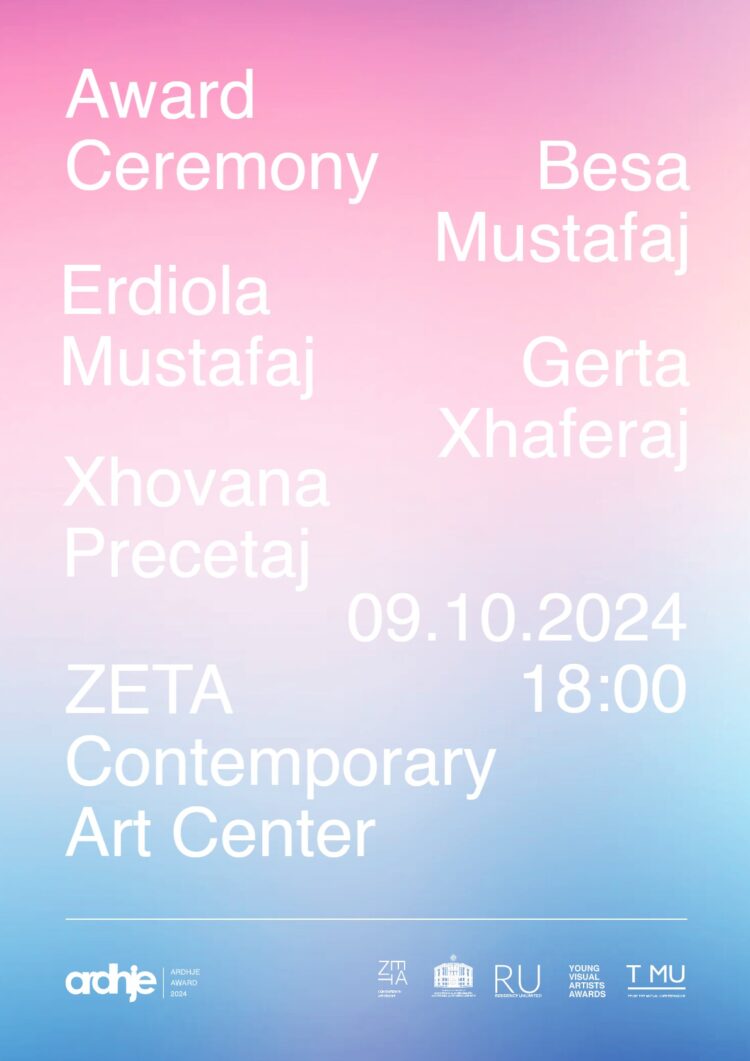2024 ARDHJE Award Finalists’ Exhibition
With artists: Besa Mustafaj, Erdiola Mustafaj, Gerta Xhaferaj, and Xhovana Precetaj
October 9, 2024 @ 18:30 – 21:00
@ZETA, Tiranë
2024 ARDHJE Award Winner will be announced during the opening of the exhibition, on October 9, 2024.
The international jury members are: Laura Raicovich, curator and writer (RU), (USA); Snejana Krasteva, curator and educator (Bulgaria) and Daphne Vitali, Curator at the National Museum of Contemporary Art in Athens (GR).
The 2024 ARDHJE Award is supported by: Ministry of Economy, Culture, and Innovation, The Trust for Mutual Understanding, Residency Unlimited, and the Young Visual Artists Awards.
The exhibition of the finalists of the Ardhje Award 2024 will remain open until October 25, 2024.
2024 ARDHJE AWARD
For contemporary artists working in Albania in the present, at a moment of radical disenchantment with economic and socio-political arrangements that translate into visual systems of representation, what does it mean to look at the past and where exactly is it located? We know that the authorship of history is also intimately tied with the distribution of power. The 2024 Ardhje Award exhibition brings together the work of four young women artists, whose heterogeneous practices, cannot be circumscribed in facile categories such a gender or country of citizenship, but that are connected through a thread that explores different spaces that are shaped or distorted by time, and that might potentially become history, or vanish as fleeting memory, depending whose gaze is fixed on the archive.
Setting the stage for artistic practices touching on history, time and memory is painter Xhovana Precetaj, presenting a new series of works on canvas, continuing her long-term exploration of theme of anti-memory, turning to French philosopher Jacques Derrida’s concept of hauntology, the unsettling persistence of elements from the past that remain as intangible shadows, yet latent, continuously influencing the present, and ready to awake from their neither-alive-nor-death state anytime. For Precetaj, memory is not a continuous narrative but an open-ended archive, disconnected from historical coherence, always fragile and distorted. For the artist, the anti-memory as hauntology is a pictorial language that destabilizes the conventional representation of memory, highlighting ambiguity and vulnerability.
Starting out from the cultural and narrative memory imbued in everyday materials, Besa Mustafaj, the youngest artist in the award exhibition, is exploring an intergenerational relationship to craftsmanship, as she grew up in the upholstery workshop of her parents surrounded by soft textiles, threads, wood, copper wire and iron bars. In her project for the award, taking these familiar materials and surfaces as a starting point, Mustafaj creates sculptures that become theatrical stages, based upon childhood fairy tales, inhabited by animated dolls, dioramas and found objects. Her theatrical scenes with animated puppets are not simply a personal way to connect with the past, but also a gesture for preserving memories beyond the passage of time.
Erdiola Mustafaj’s research-based practice places us in a specific time frame, but one that is rapidly vanishing: The memory of the Cham dialect, spoken by an Albanian minority in Northern Greece, who were displaced during the population exchanges in the 1920s, which the artist encountered in her family, after her own migration to Italy. The multicultural region of Chameria, overlapping Greek and Albanian identities, no longer exists as the territory has become Hellenized. But the artist performs an audiovisual archaeology of its traces, combining sounds from Cham and other Ottoman-era dialects, with a photographic trail to reconstruct a speculative territory in which the ephemerality of an unwritten language opens up simultaneously as both living memory and the contemporary condition of the fragment.
Closer to the political present of the country, Gerta Xhaferaj’s home-made videos, shot between 1998 and 2015, capture everyday life and celebrations, but were subsequently edited by her father, who censored many sequences, replacing them with flowers. Later on, the artist discovered that during communist-era Albania, public TV stations would fill the space of commercial breaks with images of flowers and still lifes. In her work, Xhaferaj examines oppression and the underlying social mechanisms that reinforce it, and how these power structures affect relations between peoples and their surrounding world. The need to masquerade imperfections in the home-made videos highlights the role of normative social morality in post-communist countries as an aesthetic point of view as well.
For the 2024 Ardhje Award exhibition, Albanian artists have formulated different approaches to temporality in the construction of personal and collective archives, from the pure theoretical and psychological, to the concretely cultural-historical and socio-political. The tectonic geopolitical shifts of the present shift dramatically our perception of the past, as we begin to realize that every past brought to light, actually exists only in the present and is being constantly reworked and sometimes manipulated. Through their engagement with the arbitrary nature of historical narratives and exploring different possibilities of storytelling, artists do not necessarily change the course of history, but they can make us pause for a moment and reimagine the future as if the present shed light on it as a past.
Arie Amaya-Akkermans
